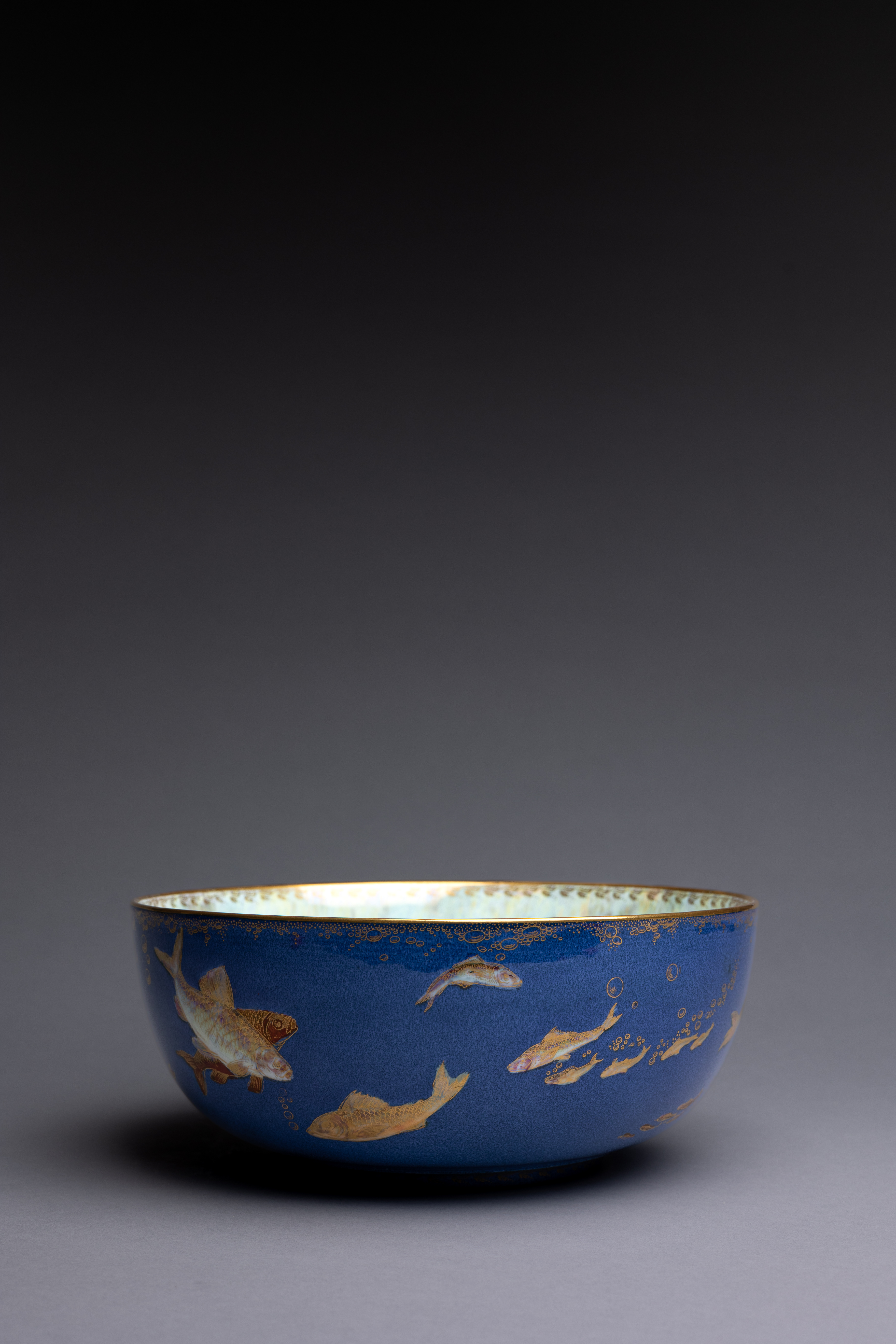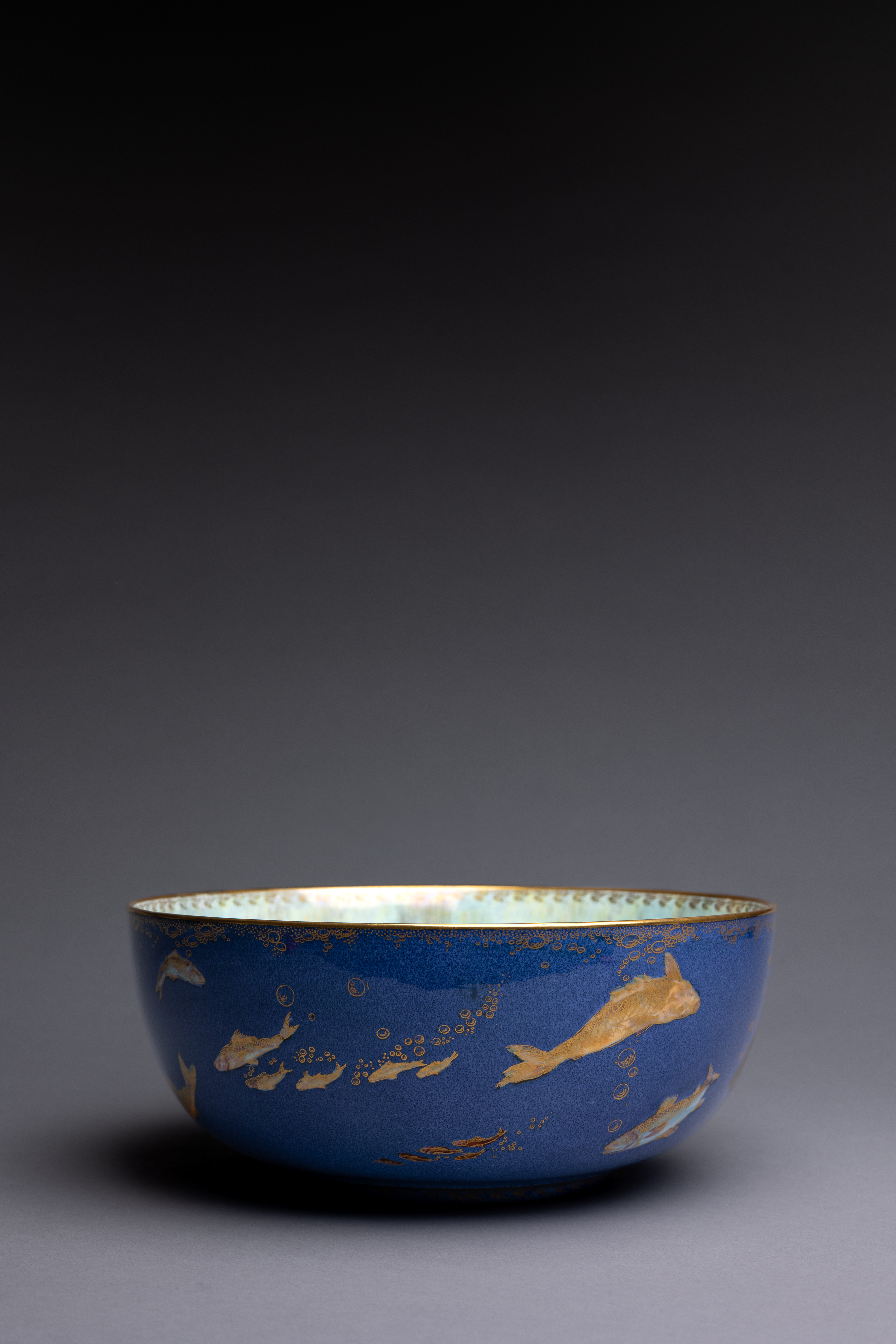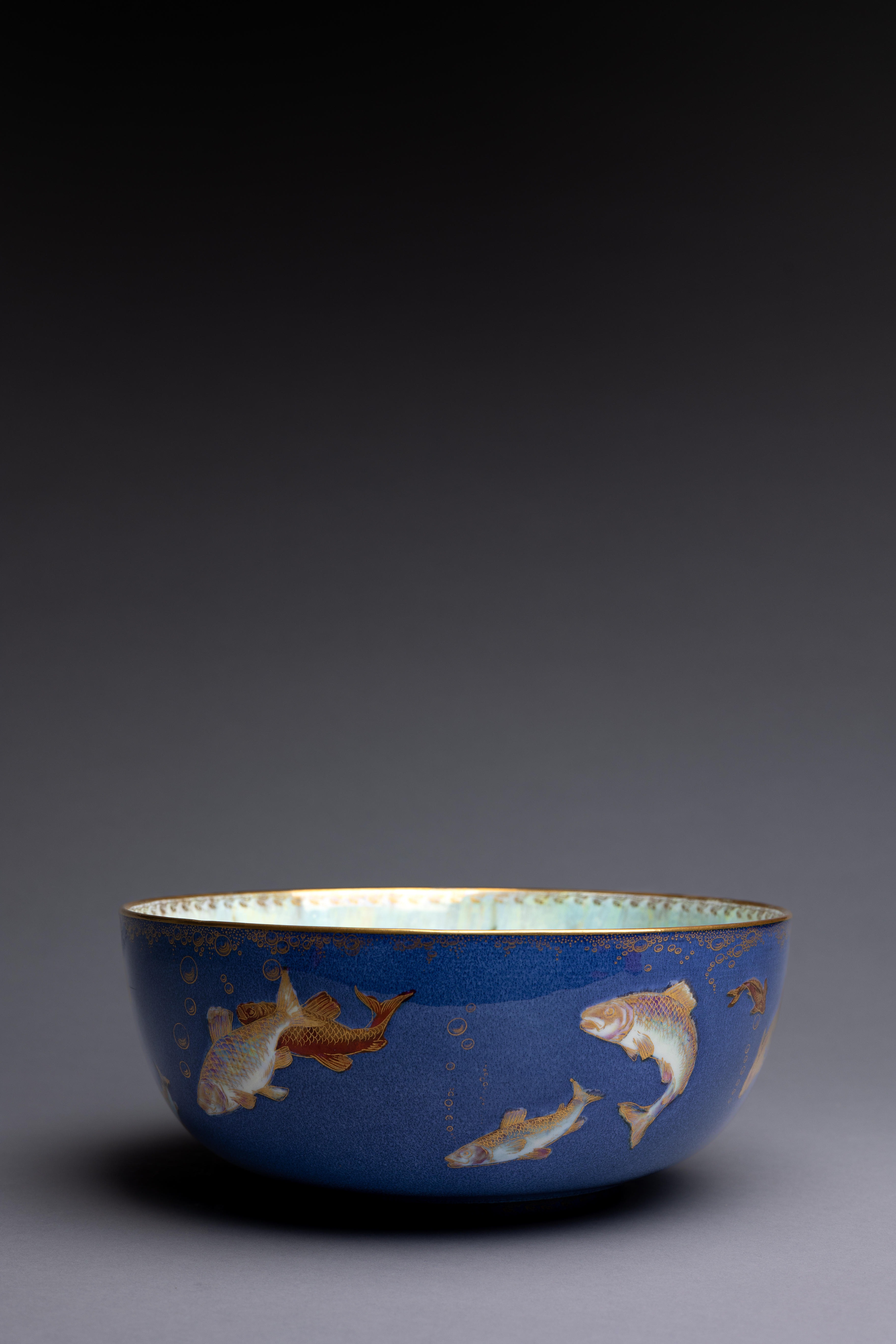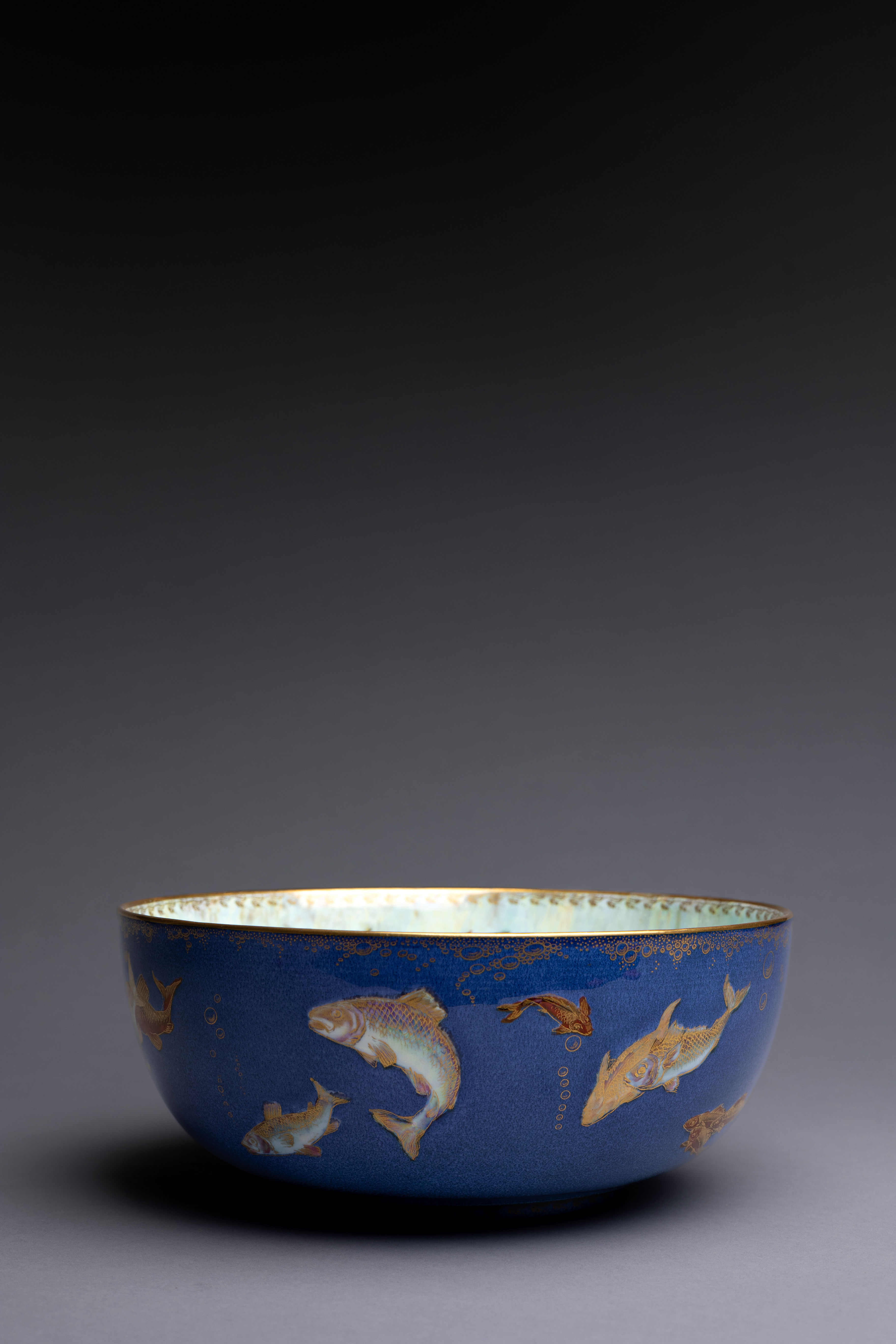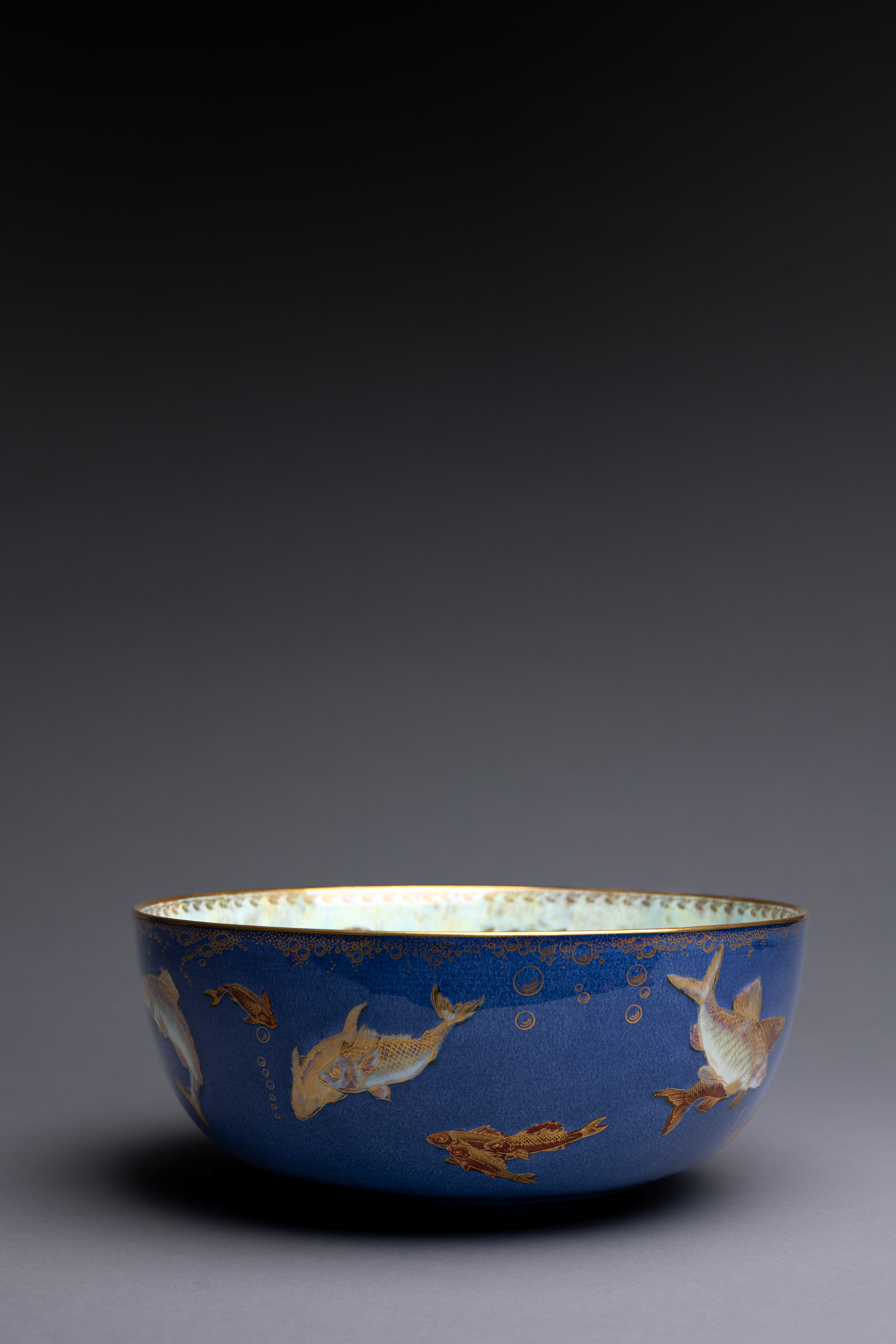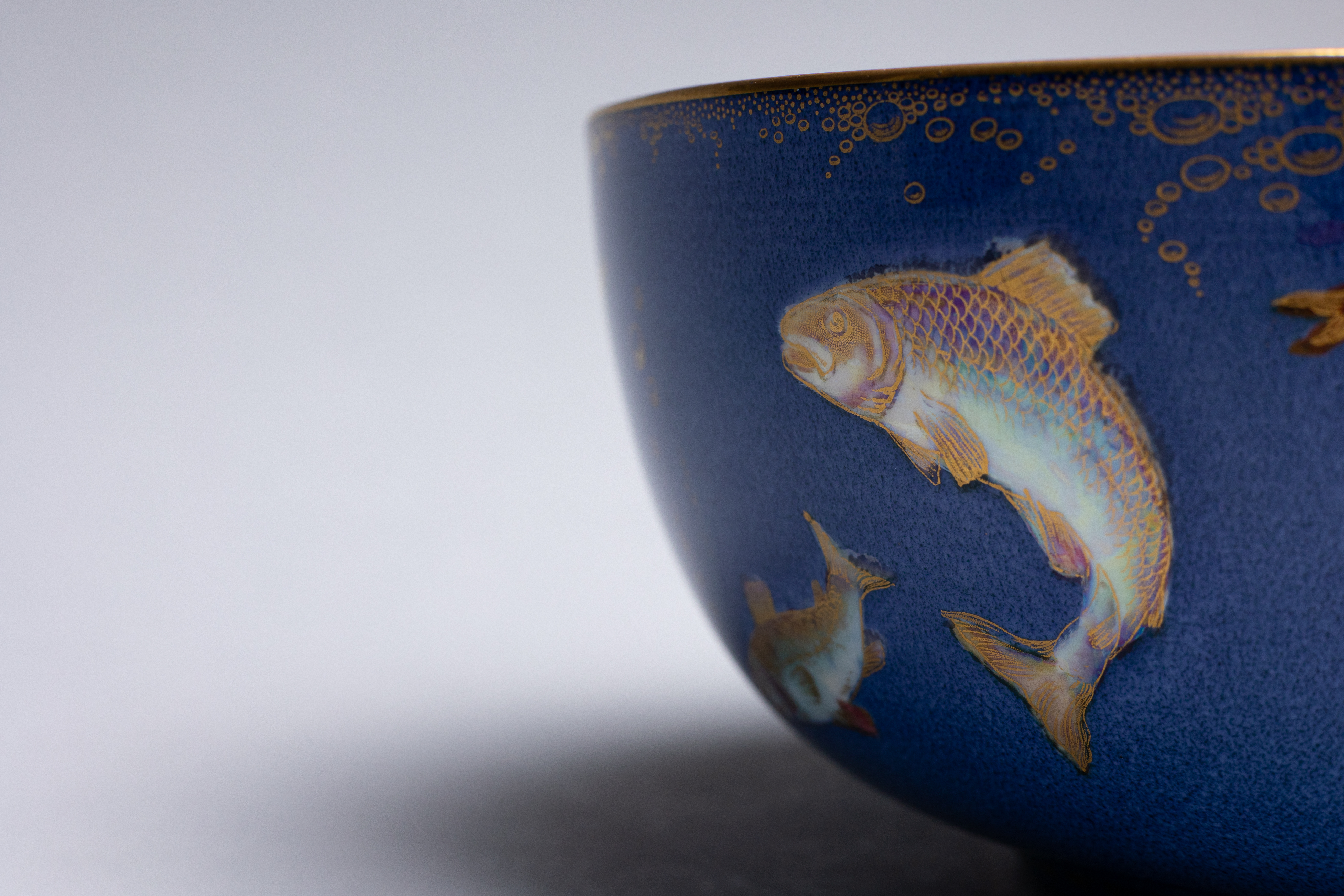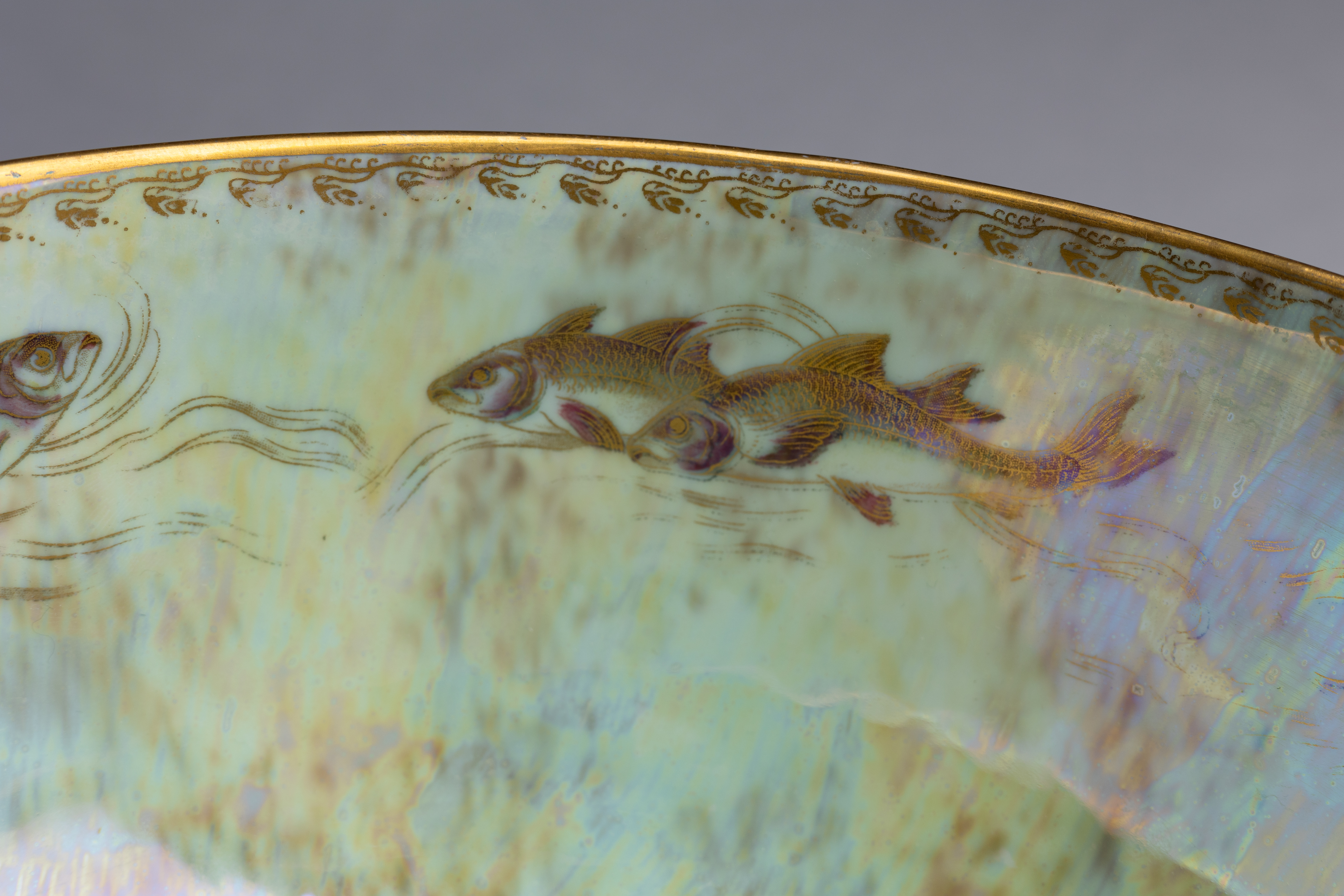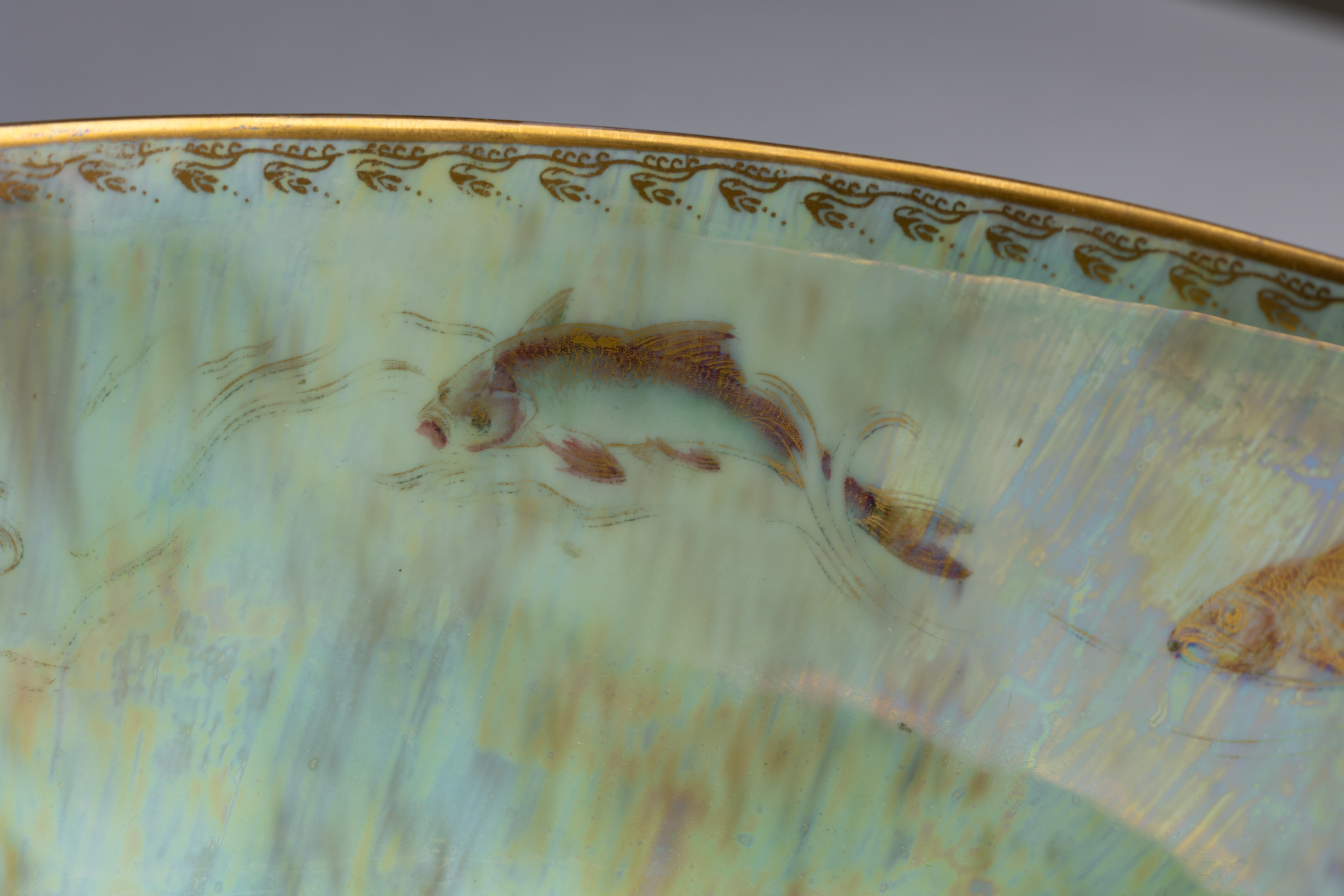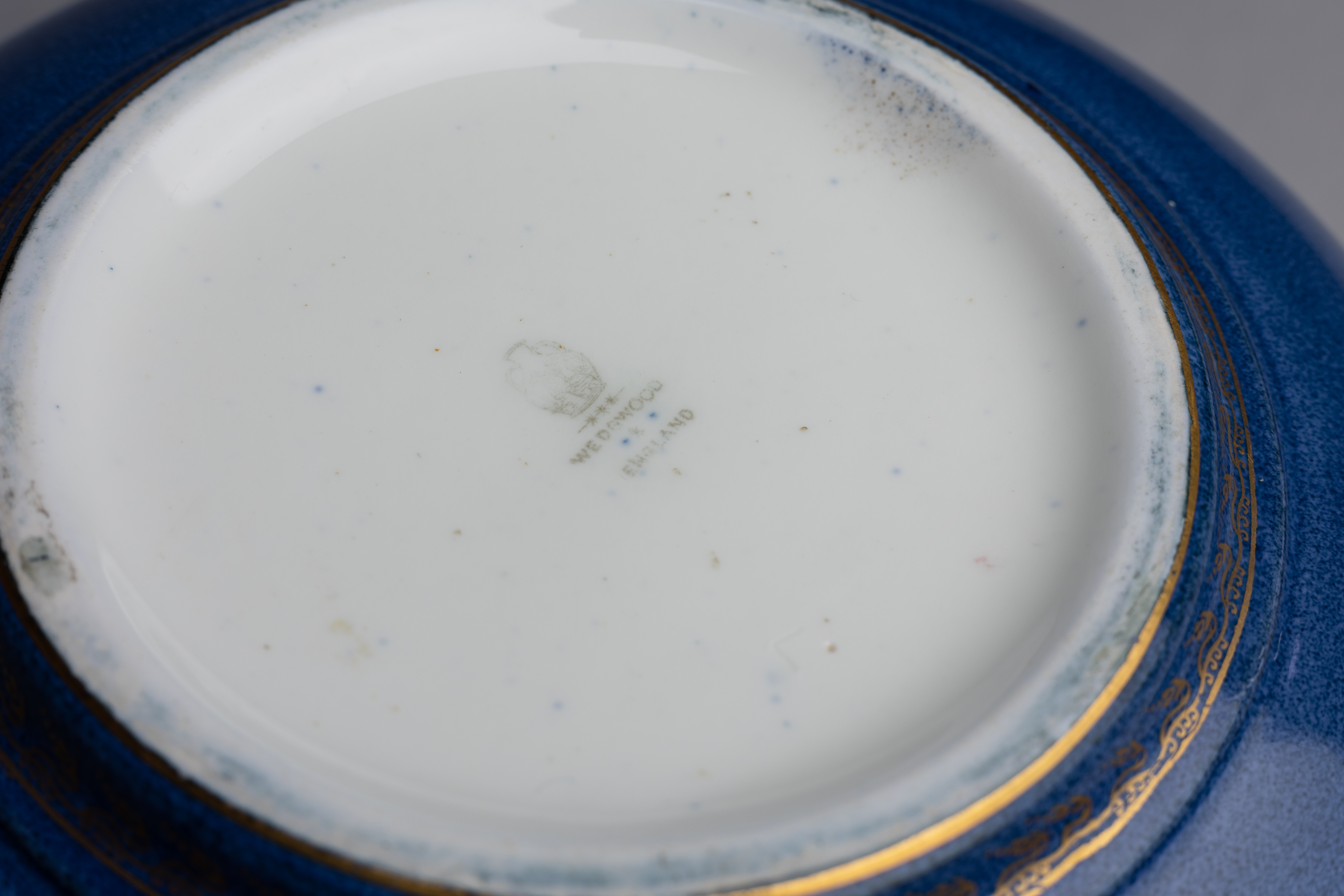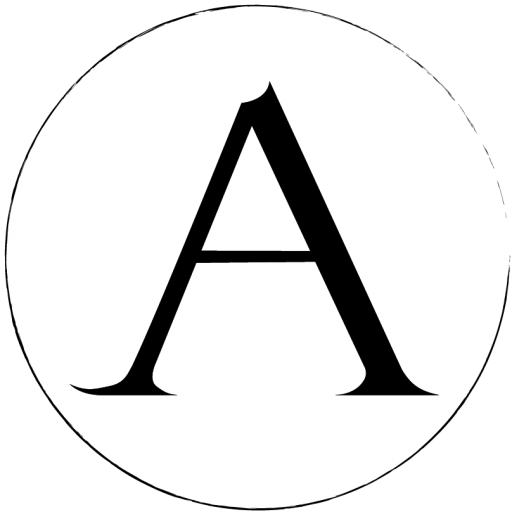This powder blue fish bowl is an homage to Daisy Makeig-Jones’s beginnings at Wedgwood. In 1912, during her training, the factory successfully created the stippled blue glazing technique that covers this pot’s surface. Makeig-Jones’s own early fish designs accent this Wedgwood powder blue bowl; to create an object of whimsy and delight.
This powder blue fish bowl is an homage to Daisy Makeig-Jones’s beginnings at Wedgwood. In 1912, during her training, the factory successfully created the stippled blue glazing technique that covers this pot’s surface. Makeig-Jones’s own early fish designs accent this Wedgwood powder blue bowl; to create an object of whimsy and delight.
Essay
During Daisy Makeig Jones’s training years at Wedgwood, the factory began experimentation to create powder-blue, or bleu soufflé, wares. It took for its model 18th-century Chinese porcelains with a chuiqing (‘blown blue’) glaze and gilded designs. In order to achieve an air-brushed effect, artisans at the Jingdezhen kilns blew powdered cobalt onto unglazed biscuit through a bamboo shoot that had a piece of very thin silk gauze at the end. A second firing secured the powder onto the piece. Chinese powder-blue wares were popular in both the Middle East and in Europe, there reserved for the homes of the upper class.
At Wedgwood, a team of the company’s four leading figures was tasked with recreating the Chinese powder-blue glaze for a middle-class market of consumers. The group, comprised of John Goodwin, James Hodgkiss, George Adams, and Bernard Moore, borrowed an 18th-century Chinese bleu soufflé piece from the Victoria & Albert Museum for thorough research and imitation.
By 1912, the men were able to replicate Chinese bleu soufflé by stippling cobalt on a glazed surface with a sponge; commercial production of powder-blue ware began in August of that year. In a stroke of kismet, Daisy Makeig-Jones’s studio was next to that of James Hodgkiss, one of the lead designers tasked with replicating the Chinese bleu soufflé. Thus she was able to observe first hand many of the experiments to develop Wedgwood powder blue (which came in handy while developing her own Lustre line) and even add some of her own designs to the powder blue wares.
An example can be seen in this stunning powder blue bowl. The exterior features a school lustrous fish delicately outlined in gold, swimming beneath a whimsical bubble border. This bowl is a larger version of one acquired by Queen Mary (and now in the V&A) who, upon visiting the Wedgwood booth at the 1916 British Industries Fair, was taken by the exquisite wares.
“The other piece was of powder blue…many attempts were made to imitate it, both by Japanese and European factories, no imitation approached the original until in 1912 when connoisseurs allow that Messrs. Josiah Wedgwood and Sons succeeded in reproducing both the colour and texture of a Chinese powder blue bowl so admirably that it was almost impossible to distinguish the imitation from the original. This piece Her Majesty selected was a combination of the two processes, viz., a powder blue background, with lustrous fish in pearl, blue, pale green, ruby and orange…”
Anonymous newspaper clipping, 1917 in Una des Fontaines, Wedgwood Fairyland Lustre: the Work of Daisy-Makeig Jones (New York: Born-Hawes, 1975), 41.
The whimsy present on this bowl conveys a playful spirit akin to Makeig-Jones’s Fairyland Lustres. Whereas Fairyland Lustres were elaborately decorated with an array of colors and covered with intricate scenes, this powder blue bowl is more restrained in its focus of a single motif, allowing Makeig-Jones’s whimsy to shine through.
BT
Condition
Excellent. Some very minor gilt wear to a few fish in the center.
For a detailed condition report, please contact us.
References
Literature
Una des Fontaines, Wedgwood Fairyland Lustre: the Work of Daisy-Makeig Jones (New York: Born-Hawes, 1975).
During Daisy Makeig Jones’s training years at Wedgwood, the factory began experimentation to create powder-blue, or bleu soufflé, wares. It took for its model 18th-century Chinese porcelains with a chuiqing (‘blown blue’) glaze and gilded designs. In order to achieve an air-brushed effect, artisans at the Jingdezhen kilns blew powdered cobalt onto unglazed biscuit through a bamboo shoot that had a piece of very thin silk gauze at the end. A second firing secured the powder onto the piece. Chinese powder-blue wares were popular in both the Middle East and in Europe, there reserved for the homes of the upper class.
At Wedgwood, a team of the company’s four leading figures was tasked with recreating the Chinese powder-blue glaze for a middle-class market of consumers. The group, comprised of John Goodwin, James Hodgkiss, George Adams, and Bernard Moore, borrowed an 18th-century Chinese bleu soufflé piece from the Victoria & Albert Museum for thorough research and imitation.
By 1912, the men were able to replicate Chinese bleu soufflé by stippling cobalt on a glazed surface with a sponge; commercial production of powder-blue ware began in August of that year. In a stroke of kismet, Daisy Makeig-Jones’s studio was next to that of James Hodgkiss, one of the lead designers tasked with replicating the Chinese bleu soufflé. Thus she was able to observe first hand many of the experiments to develop Wedgwood powder blue (which came in handy while developing her own Lustre line) and even add some of her own designs to the powder blue wares.
An example can be seen in this stunning powder blue bowl. The exterior features a school lustrous fish delicately outlined in gold, swimming beneath a whimsical bubble border. This bowl is a larger version of one acquired by Queen Mary (and now in the V&A) who, upon visiting the Wedgwood booth at the 1916 British Industries Fair, was taken by the exquisite wares.
“The other piece was of powder blue…many attempts were made to imitate it, both by Japanese and European factories, no imitation approached the original until in 1912 when connoisseurs allow that Messrs. Josiah Wedgwood and Sons succeeded in reproducing both the colour and texture of a Chinese powder blue bowl so admirably that it was almost impossible to distinguish the imitation from the original. This piece Her Majesty selected was a combination of the two processes, viz., a powder blue background, with lustrous fish in pearl, blue, pale green, ruby and orange…”
Anonymous newspaper clipping, 1917 in Una des Fontaines, Wedgwood Fairyland Lustre: the Work of Daisy-Makeig Jones (New York: Born-Hawes, 1975), 41.
The whimsy present on this bowl conveys a playful spirit akin to Makeig-Jones’s Fairyland Lustres. Whereas Fairyland Lustres were elaborately decorated with an array of colors and covered with intricate scenes, this powder blue bowl is more restrained in its focus of a single motif, allowing Makeig-Jones’s whimsy to shine through.
BT
Excellent. Some very minor gilt wear to a few fish in the center.
For a detailed condition report, please contact us.
Una des Fontaines, Wedgwood Fairyland Lustre: the Work of Daisy-Makeig Jones (New York: Born-Hawes, 1975).
This item ships free to the continental US, and globally for a flat-rate fee of $75.
All objects are packed with utmost care by our team of expert fine art shippers. All items are shipped with parcel insurance.
For more information on our shipping policies, please visit our FAQ Page.

